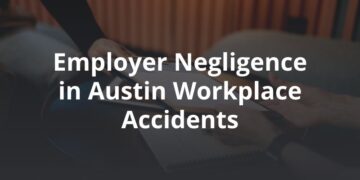A car accident leaves no doubt in your mind, from the moment of impact, that you are in for a long, potentially difficult road. Even if your injuries are not permanently life-altering, recovering from an accident means time away from your work, your family, and your favorite activities. You will be dealing with the consequences of a seriously damaged or even totaled vehicle — and then there are the insurance companies.
Insurance adjusters want to close your case as soon as possible. While that can sound like a relief at first, the fast, easy settlements are often for far less than the full value of your actual damages. You also need to consider that the full scope of some common car accident injuries takes time to develop. In some cases, symptoms may even be delayed. Back pain after a car accident is just one example of a symptom that can appear after the initial shock of the accident has worn off — and just one of many reasons it is important to learn about your options from an Austin personal injury lawyer right away.
1. Whiplash
Whiplash is a serious injury with a funny name. Affecting more than two million Americans a year to varying degrees, whiplash is a neck injury that results from a violent and quick snapping motion of the neck. The weight of the head and the force of an impact can cause soft tissue damage and even bone fractures.
Symptoms of whiplash include:
- Neck pain and stiffness
- Headaches
- Pain in the shoulder, upper back, or arms
- Tingling or numbness in the arms
- Fatigue
- Dizziness
Twelve percent of all people involved in car crashes are diagnosed with whiplash, and that may not even be a complete number. Whiplash can disguise as other injuries or even be so mild at first that it’s overlooked in all the other stresses of being in a collision. Because whiplash often does not appear until day two or three — or more — after a crash, many people do not seek treatment until they are suffering excruciating pain, immobility, or unshakeable symptoms.
Just because it’s common does not mean that whiplash cannot be serious. The damage that is done by violent force on a person’s neck can be severe, and it can cause life-long problems. In some cases, these problems might have been avoided if extended treatment had been available, like physical therapy.
2. Concussion
Another above-the-shoulders injury is a concussion. Long considered by many people as a minor consequence of normal rough-and-tumble play, athletics, and the occasional fender-bender, concussions are now rightfully understood as the serious traumatic brain injury (TBI) it is. A concussion results when force, whether a blow or bump to the head or a whiplash-type movement, causes the brain to bounce or twist in the skull.
A concussion alone is not necessarily life-threatening, but they are serious. Repeated concussions, even mild, or injury to an already-concussed brain can be especially dangerous, so it is important to know when you have experienced a concussion. Generally, the symptoms of the most severe concussions will be obvious right away:
- dizziness
- blurred vision
- memory loss
- loss of consciousness
Unfortunately, the symptoms of a mild or even moderate concussion can take time to develop or become apparent to the injured person, especially if they have experienced other injuries that are more obvious up-front. In one study of student athletes, nearly a quarter of participants experienced delayed onset of concussion symptoms.
When it comes to a concussion, it is important to understand what delayed can mean, especially in contrast to some other injuries. In the study of student athletes, the goal of the study was to ensure proper protocols that would keep students safe, such as not returning them to a game if concussion was a possibility. For this reason and because of the nature of a concussion, delayed symptoms were defined as symptoms that appeared more than 15 minutes after the potential injury or impact occurred.
The median amount of time that elapsed between injury and the onset of symptoms for those who were considered to experience delayed onset was only 60 minutes but think about all that can happen in the 60 minutes after a car accident, especially if you think you are uninjured.
In 60 minutes, you might have been looked over by first responders, given a statement to police, shared insurance information with another driver, called a tow truck, had your vehicle towed, and be on your way home. By the time you might realize you are experiencing symptoms, you are likely already busy dealing with the aftermath of the accident, or you are already at home, a little sore, and you don’t want to go back out.
However, the longer you delay treatment, the more chance you have of experiencing long-term effects from your concussion — in the previously mentioned study, the correlation between delayed onset and treatment of concussion was that participants experienced symptoms for more than three months.
3. Internal Bleeding and Hemorrhagic Shock
If internal bleeding doesn’t sound scary enough, what about occult bleeding? How about hemorrhagic shock? We promise we are not out to scare you, but the medical terms used to talk about these dangerous and potentially deadly hidden and delayed-symptom injuries just happen to be appropriately spine-chilling.
Occult bleeding is bleeding that is not easily apparent to either the patient or their doctor, and hemorrhagic shock refers to the body’s lack of oxygen at the cellular level as a result of blood loss. The most common causes of both of these dangerously difficult-to-diagnose injuries are blunt trauma and penetrating wounds, both of which are especially common in car accidents.
Unfortunately, it doesn’t take ignoring medical care altogether to miss these kinds of injuries. In fact, it can even be the presence of other injuries that make it more difficult to notice the onset of internal symptoms of dangerous bleeding-related injuries. Pelvic fractures, which studies show are increasing rapidly in car accidents, can even hide internal bleeding, as can femur fractures.
4. Blood Clots and Hematomas
Like internal bleeding, blood clots can take time to present after a car accident, and unfortunately may not even be noticed until they are life-threatening or even fatal. Blood clots can form as the result of blunt force trauma, and while the clots themselves are generally not dangerous, the consequences can be severe if they break away and travel to the lung or brain.
One such example is a condition known as deep vein thrombosis or DVT. With DVT, a clot forms in the deep veins of the body’s muscles, most often in the leg. Symptoms of DVT can mimic other, less serious ailments or even be mistaken for “normal” soreness after an accident:
- muscle pain
- swelling
- soreness/aching
- redness or warmth in the affected area
- low-grade fever
One of the more serious consequences of DVT comes in the form of a pulmonary embolism, which is when the clot travels to the lung. If caught early, pulmonary embolisms can be treated, so it is especially important not to ignore a rash of new symptoms, including:
- shortness of breath
- chest pain
- coughing
- fever or clammy skin
- rapid or irregular heartbeat
- lightheadedness or dizziness
- excessive sweating
Another injury with delayed onset of symptoms is a hematoma, which is a collection of blood outside the blood vessels. Many people see the signs of minor hematomas constantly: bruises. However, in the most serious cases, hematomas can cause severe and even deadly results, such as when an artery is affected or when the hematoma results in damage to an organ, such as in the case of the person whose kidney continued to fail, unnoticed, for weeks after being damaged in a seatbelt injury.
5. Back injuries
Who isn’t sore after a car accident, right? Back pain after a car accident is extremely common, but it may not happen right away — more importantly, you may not realize right away there’s more to it than just a simple ache. In fact, a meta-analysis of 1136 articles found that 63 percent of patients with chronic lower back pain were initially injured in a motor vehicle accident.
Not only can back pain take months or even years to fully develop, but the many kinds of back injuries and their many symptoms can be difficult for injured people to articulate and even for doctors to diagnose and treat. Herniated and bulging discs, spinal stenosis, and spinal fractures of dislocations can all take time to present as more than just a muscle ache, but unfortunately, they also are known to progress and worsen over time, especially if left untreated. Some of the symptoms to look out for, even long after your accident, include:
- Pain in the neck or back
- Numbness and tingling in the arms or legs
- Muscle spasms
- Weakness and fatigue
- Loss of bladder or bowel control
- Cramps in the legs
- Problems with balance
- Headaches
- Weakness
- Difficulty breathing
Back pain should never be taken lightly, especially after a car accident. The spine is a delicate system that is the entirety of your body’s central support system. Not only can any of its three primary sections be permanent, but damage to the spine can cause life-threatening secondary complications, such as pneumonia and septicemia. Thankfully, in many cases, if the onset of symptoms is delayed, that may mean an increased chance of stopping the damage in its tracks and, in some cases, even recovering from it.
6. Psychological Injuries
PTSD is a serious and not uncommon psychological consequence of traumatic events like car accidents. Car accidents cause most people to experience the body’s natural “fight or flight” response, which can lead afterward to short-term feelings of distress, anxiety, fear, or even heightened senses of elation for having survived a dangerous event. These are all normal stress responses, but sometimes those normal stress responses continue on, leading to additional symptoms. Common symptoms of PTSD include:
- Intrusive thoughts or experiences, like flashbacks or nightmares
- Avoidant behaviors, like refusing to get in a car or listen to the song that was playing at the time of the car accident
- Negative mood changes, like feelings of shame, guilt, or detachment
- New or worsened behaviors or responses, like irritability, recklessness, or fear
Most people begin to experience symptoms of PTSD within the three months after the car accident, but they can begin occurring at different times and may not immediately be connected. In other cases, people with PTSD from a car accident may not experience symptoms for days, weeks, or even months after their accident.
What Causes Delayed Symptoms After a Car Accident?
The reasons for delayed symptoms after a car accident are varied. In some cases, it may be that the initial injury simply hasn’t had time to hurt you yet, such as in the case of internal bleeding. In other cases, like a blood clot, it may be because the clot itself has not worked its way up toward being dangerous.
In many cases, the delay of symptoms is directly the result of your body’s incredible ability to care for itself. When your mind knows you are in danger, your body reacts. The fight or flight response is really the quick and powerful release of adrenaline. This adrenaline release can mask the symptoms of physical injuries.
When a car accident results in fatalities, survivors often experience additional psychological impacts. However, these impacts may be confused for grief, or the grief response may delay the onset of PTSD symptoms.
What can/should you do if you experience symptoms after a car accident?
What kind of medical care and costs might ensue?
What kind of recovery is available legally, and what’s the process of seeking recovery like?
How Can You Recover Financially After a Car Accident?
When injury victims experience delayed symptoms, they might worry that their legal recovery options are limited. However, the complexities of personal injury cases and issues of proving connections to the accident or statutes of limitations are complex and specific to each case.
Many insurance companies try to scare off potential lawsuits with casual mentions of the statute of limitations, but this period of time that people who are injured have to file a lawsuit for recovering damages is not always calculated by the date of the accident itself. As for proving how injuries are connected to your accident, even down the road, doctors who understand these types of injuries — and personal injury lawyers who are experienced with these kinds of cases — know how to connect the dots between your symptoms and the harm that was done to you.
That does not mean you can’t take steps early on after your accident to protect your rights. Anytime you are in a car accident — or as soon as possible after the fact — make sure to:
- Get medical help right away, even if you think you are okay
- Document your injuries and symptoms
- Take note of other people’s observations of your behavior or symptoms
- Don’t ignore medical advice or treatment
- Keep records of your expenses related to your injuries
- Seek medical help anytime your symptoms change or worsen
Insurance companies will almost always try to use your lack of medical care as an excuse to devalue or deny your claim; while that is never a guaranteed defense, you never want to find yourself in grave danger, health-wise, or with less medical documentation for your case because you avoided care. In some cases, a car accident may aggravate pre-existing back injuries or conditions you may not have even known about, like with spinal stenosis cases. The sooner you have medical documentation about where your condition was before or at the time of the accident compared to when you started experiencing symptoms, the more evidence you have to prove how impactful the accident was in causing you harm and how it may continue to worsen in the future.
In addition to the costs of your medical treatment, the kinds of damages you may be eligible to be compensated include:
- Lost wages or earnings
- Lost future earnings
- Pain and suffering
- Diminished quality of life
- Funeral and burial expenses
In some cases, you may be eligible for punitive damages, which are awarded to survivors of accidents as punishment to the person or people responsible for causing you harm.
How Can FVF Help?
Our Austin car accident lawyers understand how traumatic a car accident can be, but we also understand that it’s an ongoing process that not only takes time to heal but can even get worse than you initially thought. Making decisions about what to do in the aftermath of a car accident might be difficult, but it is definitely easier with the help of an experienced team whose primary mission is to educate and empower people who have been injured, even if we never represent them in court. Contact us today to get started.







